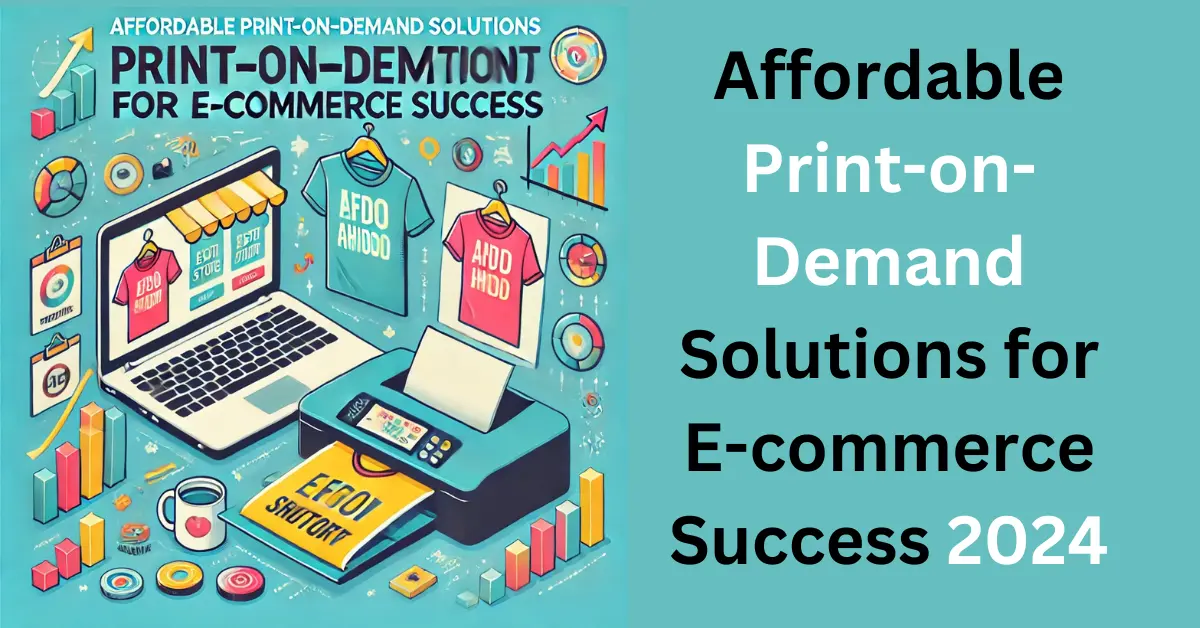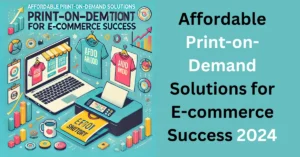In today’s fast-paced e-commerce landscape, entrepreneurs seek low-risk, scalable business models that require minimal upfront investment. Print-on-Demand (POD) has emerged as an effective way to build a brand and generate revenue with less hassle. Whether you’re an artist, an influencer, or an e-commerce newbie, POD allows you to sell customized products without holding any inventory.
In this guide, we’ll dive deep into what Print-on-Demand is, why it’s a powerful tool for e-commerce success, and explore affordable POD platforms that can help entrepreneurs thrive.
What is Print-on-Demand?
Print-on-Demand (POD) is a fulfillment model where products such as T-shirts, hoodies, mugs, phone cases, and more are printed only when an order is placed. With POD, businesses don’t need to stock physical inventory. Instead, the printing process begins when a customer places an order, and the product is directly shipped to them by the POD service provider.
This business model eliminates many of the risks associated with traditional retail, such as overproduction, unsold stock, and expensive storage fees. It also opens up room for creativity since sellers can offer a wide range of personalized designs to meet customer demands.
Why is Print-on-Demand a Game-Changer for E-commerce?
POD offers several benefits that make it attractive for entrepreneurs looking to enter the e-commerce space or expand their existing business.
Low Upfront Costs
Since products are printed and shipped on demand, sellers don’t need to invest heavily in inventory. All that’s required is the cost of the design and a small platform fee, depending on the service provider.
No Inventory Management
Managing inventory can be expensive and complicated. With POD, the service provider takes care of production and fulfillment, leaving you to focus on marketing and growing your brand.
Highly Customizable Products
Print-on-Demand allows businesses to cater to niche markets by offering personalized products. This flexibility helps sellers stay ahead of trends and attract loyal customers.
Scalable Business Model
You can start small and gradually increase product offerings based on customer feedback. With no production limits, scaling your business becomes easier and more manageable.
Environmentally Friendly
Since products are created only when there’s demand, POD reduces waste, making it a more sustainable option compared to bulk production methods.
Top Affordable Print-on-Demand Platforms for E-commerce Success
Several POD platforms are available today, each with unique offerings. Here are some affordable solutions that cater to different business needs:
1. Printful
Printful is a popular POD platform known for its seamless integration with major e-commerce platforms like Shopify, WooCommerce, and Etsy. It offers a wide range of products, including apparel, home decor, and accessories.
Pros:
- No upfront fees
- Fast shipping options
- High product quality
Cons:
- Product prices can be on the higher side
Best For: Sellers who prioritize quality and want a straightforward setup with integration options.
2. Printify
Printify is another great option that allows sellers to choose from multiple print providers worldwide. This flexibility lets you pick the best price and shipping option for your customers.
Pros:
- Free plan available
- A large catalog of customizable products
- Global fulfillment partners
Cons:
- Inconsistent product quality between different providers
Best For: Entrepreneurs looking for affordable product options and international shipping flexibility.
3. Teespring (Now Spring)
Teespring is an easy-to-use platform that focuses on apparel and accessories. It has evolved into a social commerce tool, making it perfect for creators who want to sell directly through their social media channels.
Pros:
- No setup fees
- Built-in marketing tools
- Suitable for influencers and creators
Cons:
- Limited product categories compared to other platforms
Best For: Social media influencers and content creators with a loyal audience.
4. Gooten
Gooten is an affordable POD platform with a focus on product variety and automation. It offers integration with Shopify and WooCommerce, making it suitable for businesses looking to streamline their order management process.
Pros:
- Competitive pricing
- Automated order management
- Large product catalog
Cons:
- Limited design tools
Best For: Sellers aiming for automation and a diverse product selection.
5. Redbubble
Redbubble is a marketplace-style POD platform that attracts artists and designers. It handles all aspects of fulfillment, including marketing on its platform, giving sellers the opportunity to reach a larger audience.
Pros:
- No upfront costs
- Built-in marketplace traffic
- Easy-to-use platform
Cons:
- Lower profit margins due to Redbubble fees
Best For: Independent artists looking to monetize their designs.
Tips for Success with Print-on-Demand
Success with POD requires more than just uploading designs. Here are some tips to boost your e-commerce game:
1. Choose the Right Niche
Targeting a specific niche increases your chances of success. Whether it’s pet lovers, gamers, or travelers, understanding your audience helps you create products that resonate with them.
2. Focus on Design Quality
The appeal of your designs can make or break your POD store. Invest in high-quality graphics or collaborate with designers to create attractive artwork that stands out.
3. Leverage Social Media for Marketing
Platforms like Instagram, Pinterest, and TikTok can drive traffic to your store. Use social media marketing techniques such as influencer partnerships, paid ads, and engaging content to attract customers.
4. Offer Limited-Time Products
Creating urgency by offering limited-edition items or seasonal collections encourages impulse buying and increases sales.
5. Optimize Your Product Listings
Use keywords strategically in product titles and descriptions. Focus on terms like “custom T-shirts,” “personalized gifts,” or “eco-friendly home decor” to improve your store’s visibility on search engines.
Overcoming Common Challenges with Print-on-Demand
Like any business model, POD has its challenges. Here’s how you can address them:
- Long Shipping Times: Partner with print providers closer to your target market to minimize shipping delays.
- High Product Costs: Balance profitability by choosing providers with competitive prices and bundling products to increase the average order value.
- Design Copyright Issues: Ensure your designs are original or properly licensed to avoid copyright violations.
- Customer Returns: Have a clear returns policy to handle disputes effectively and maintain customer satisfaction.
Many POD providers integrate seamlessly with popular e-commerce platforms. Shopify, WooCommerce, Etsy, and BigCommerce are among the best options. Services like Printful and Printify offer direct integrations, enabling automated order processing and fulfillment. Shopify is a top choice for many due to its ease of use and customizable store templates, while Etsy is ideal for sellers targeting handmade or artistic products.
POD can be highly profitable with the right strategy. Profit margins depend on the products, platform fees, and design quality. Custom products often have higher perceived value, allowing sellers to price them competitively. To increase profitability, focus on niche markets, offer bundles, and optimize shipping costs. However, businesses should also consider challenges like product costs and shipping times when calculating margins.
Conclusion
Print-on-Demand is a powerful tool for anyone looking to start or grow an e-commerce business with minimal risk. Its low-cost, low-inventory model makes it accessible, and the ability to offer unique, personalized products ensures there’s always demand.
Choosing the right POD platform is crucial for your success. Whether you opt for Printful, Printify, Gooten, or another service, make sure it aligns with your budget, product needs, and long-term business goals. Combine that with a strong marketing strategy and excellent product design, and your path to e-commerce success becomes much smoother.
With the right mindset and tools, your journey into Print-on-Demand can be both profitable and fulfilling. Now is the time to take the plunge—launch your store, connect with your audience, and start turning your ideas into tangible products.
By leveraging the Print-on-Demand model, you can achieve e-commerce success without the typical challenges associated with traditional retail, making it an exciting opportunity for entrepreneurs in today’s digital world.

